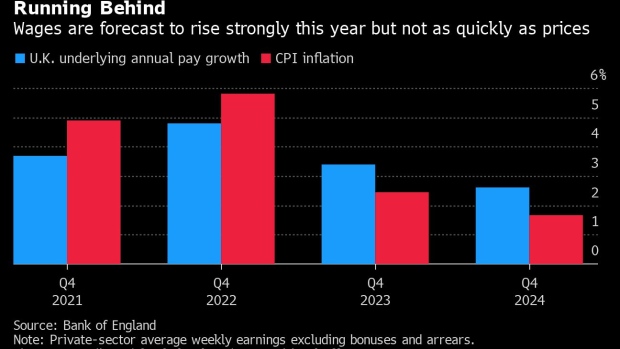U.K. Can Afford Inflation-Beating Pay Rise for Public Workers
, Bloomberg News

(Bloomberg) -- The U.K. government can afford to give the country’s 5.5 million public-sector workers an inflation-busting pay rise, according to its own official forecasts.
Negotiations with unions are under way, but the Treasury has advised public-sector pay review bodies, which make the final recommendations, to use the 2% inflation target as a guide rather than Bank of England’s forecast of 5.75% for this year.
Figures buried in Office for Budget Responsibility documents, however, reveal that government spending plans assume the public-sector wage bill increases by 6.7% in the fiscal year starting next month. A pay rise of that amount would almost certainly be enough to match the annual rate of inflation even after accounting for the rise in energy prices since Russia’s invasion of Ukraine.
Both private and public-sector employers are currently locked in pay negotiations, with January and April key months for settlements. Staff want wages to keep up with surging inflation and a shortage of workers is giving them rare bargaining power. The BOE expects private-sector wages to rise 5% this year, significantly more than usual but a pay cut in real terms.
Last month, the government proposed a 3% pay rise for the National Health Service’s 1.3 million staff, arguing that there are “stark trade-offs between pay and other NHS spending.” Unison, the public services union, said the “tight fisted” offer “is a wage cut in all but name.” The NHS pay review body is now considering what to recommend.
OBR projections suggest the big increase in departmental spending announced in the October budget may be enough to both meet government plans for public service provision and increase pay significantly for public-sector workers, who have been subject to freezes and tight pay-rise caps during most years since the financial crisis.
It assumes pay-per-head rises on average by 5.3%, the largest increase the fiscal watchdog has projected in at least a decade. Forecast growth in the number of public-sector workers means the total wage bill rises by 6.7%.
The OBR said the figures “shouldn’t necessarily be treated as a fully fledged forecast.” Instead, they are extrapolated from departmental spending plans using “judgment” on the split between spending on public services and pay.
A Treasury spokesman said: “Assumed pay bill growth cannot be derived from these statistics. Pay increases need to be proportionate to the pay rises in the wider economy, balanced with the need to manage the country’s long-term economic health and protect public-sector finances.”
The OBR assumption that staff numbers will increase flies in the face of government plans. The Treasury has said it wants to cut the “non-frontline civil service” to pre-pandemic levels by the end of the current parliamentary term in 2024-25. The civil service is a sub-set of public-sector workers who directly support government.
Jacob Rees-Mogg, minister for Brexit opportunities and government reform, said that would mean 65,000 job cuts. Thousands more will be let go as the government scales back test and trace, which employs an army of contractors though the UK Health Security Agency.
Paying the wages of Britain’s public-sector workforce cost 165 billion pounds ($218 billion) in 2021, Office for National Statistics figures show. The bill has increased by 20% in two years as headcount ballooned by 220,000 since the start of the pandemic.
The Treasury has said savings from reducing headcount will be directed back into public services but they may also help Chancellor of the Exchequer Rishi Sunak as he looks to meet rocketing debt-interest costs, an increase in military spending to face down Russian aggression and deliver tax cuts he has promised.
A 100,000 reduction in total headcount would save 2 billion pounds a year, assuming an average wage of 20,000 pounds. The benefit for the public finances would be even greater as the OBR assumes that the public-sector workforce grows by about 200,000 in the coming years, including an increase in 2022-23.
No comments:
Post a Comment